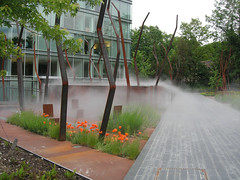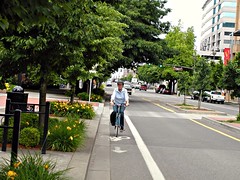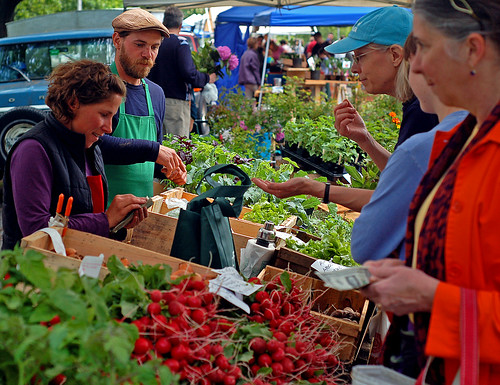Can communities foster wellness of body, mind and spirit?

Posted January 3, 2011 at 1:30PM
I wrote quite a bit toward the end of last year about the connection between places that are sustainable environmentally and those that are sustainable as a matter of health, notably this post on walkability (which I should have retitled) and this one on “healing cities.” Considering those connections was a step in the right direction, but we need to go farther.
I think it bugs some of my more focused colleagues ("We need tangible environmental targets! Metrics! Focused work plans!") both within NRDC and outside, but for me a concentration only on the measurable – or even only on the environmental – can lead to a world (not to mention a vocation) without soul and feeling. In 2011 it’s simply not enough, and I believe we do ourselves and our heirs a disservice if we do not take a more holistic view in crafting our ambitions. I have no interest in advocating places that are sound environmentally without regard to whether they also nourish the mind and spirit.
 Fortunately, the two approaches are not inconsistent. One can have places that support cleaner air, water, and climate, that respect and conserve nature, while also providing respite and human regeneration, connection to each other and to things larger than ourselves.
Fortunately, the two approaches are not inconsistent. One can have places that support cleaner air, water, and climate, that respect and conserve nature, while also providing respite and human regeneration, connection to each other and to things larger than ourselves.
In my post on healing places, I invoked my friend and architect Steve Mouzon, who clearly travels this path in his own writing and work. Today I want to point you to another of Steve’s provocative essays, which I think provides excellent food for thought (as well as a little bit of thought about food, heh) for the new year. In it he describes “wellness lenses” of body, mind and spirit through which one can consider the built environment. In each case Steve equates wellness with basic health, or absence of illness, if you will; but there is also a higher aspiration of “fitness,” to which places can also contribute.
Sustainable places can nourish wellness and fitness of body, he writes, with access to healthy food, opportunities for physical activity (“great places to bike, walk, and run”), and reducing the risk of automobile accidents. I would add, and I’m sure that Steve wouldn’t disagree, that clean air and water, and access to a range of health services are critical components, too. These, too, can be influenced if not entirely controlled by how we conceive the built environment. (Steve is attempting to set a frame, not provide all the elements or answers, and promises more in future writing while also referring back to his excellent 2010 book, Original Green.)
 Wellness and fitness of mind are fostered by the connections that come with true community, and by access to nature. The research certainly supports those points, and I would add that a little peace and quiet helps, too. That’s something a lot of density advocates fail to consider adequately: we need places of reflection as well as of activity and stimulation. While nature - if present - often supplies the latter, it does not always do so. I also think that mental health requires urban systems that work well, such as transportation options that relieve stress through comfort, efficiency and reliability rather than creating it with noise, uncertainty, fear and congestion. And perhaps above all, our communities and neighborhoods need good schools, without which wellness of mind becomes just about impossible for kids and their families.
Wellness and fitness of mind are fostered by the connections that come with true community, and by access to nature. The research certainly supports those points, and I would add that a little peace and quiet helps, too. That’s something a lot of density advocates fail to consider adequately: we need places of reflection as well as of activity and stimulation. While nature - if present - often supplies the latter, it does not always do so. I also think that mental health requires urban systems that work well, such as transportation options that relieve stress through comfort, efficiency and reliability rather than creating it with noise, uncertainty, fear and congestion. And perhaps above all, our communities and neighborhoods need good schools, without which wellness of mind becomes just about impossible for kids and their families.
Steve reaches some of those points, such as the need for places of reflection, under his discussion of wellness of spirit. And, while recognizing that many matters of the spirit have little to do with the built environment, he hits his stride in this section:
“Wellness of spirit increases when we love our neighbors... but the co-inhabitants of countless subdivisions aren’t really neighbors because the places are designed in such a way that people seldom meet and speak with each other.
So how can we love our neighbors if we don’t have any?
“Wellness of spirit grows when we do good for others less fortunate. Unfortunately, the American development paradigm has become excruciatingly efficient at separating classes of people in a very fine-grained way so that it is now possible to go interminably through one’s daily life in many places in sprawl without ever seeing anyone notably less fortunate. So how are we going to do good for others less fortunate if we never see them?"
Steve continues by stressing the value of time:
“[T]he focus of our built environment in recent decades has been all about getting bigger and getting more. And we’ve mortgaged ourselves within an inch of our financial lives... or beyond, as many have sadly discovered. Which means that we have to spend countless hours working to pay for it all.
“So it all comes back to time: spending all our time working break-neck for natural things assures that there’s no time left to build our spiritual wellness.”
That rings true, if also a bit depressing.
 (I put the phrase “natural things” in bold because Steve doesn’t mean “working for natural things” in the sense of working on behalf of nature. He really means - I think – using one’s time working for money in order to pay for tangible or material things instead of setting time aside for matters of spirit. Unfortunately, and perhaps paradoxically, I can attest from personal experience that it is just as easy to spend all one’s time on work motivated by idealism on behalf of nature - and thus neglect the spirit - as it is when the work is motivated by material desires. It’s hard to rest when one is judged by whether one changes the world.)
(I put the phrase “natural things” in bold because Steve doesn’t mean “working for natural things” in the sense of working on behalf of nature. He really means - I think – using one’s time working for money in order to pay for tangible or material things instead of setting time aside for matters of spirit. Unfortunately, and perhaps paradoxically, I can attest from personal experience that it is just as easy to spend all one’s time on work motivated by idealism on behalf of nature - and thus neglect the spirit - as it is when the work is motivated by material desires. It’s hard to rest when one is judged by whether one changes the world.)
“The Wellness Lenses of the Original Green” is not long and does not, as I wrote above, seek to provide answers. Its purpose is to get us thinking. Mission accomplished, in my case. Read it here.
Move your cursor over the images for credit information.
